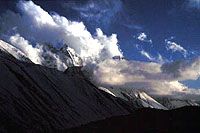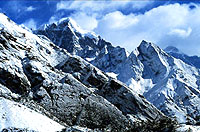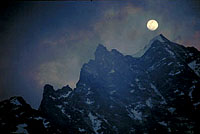
|
 |
 |
 Birth of the Himalaya
Birth of the Himalayaby Roger Bilham Photography by Liesl Clark The Continental Shuffle Over two hundred fifty million years ago, India, Africa, Australia, and South America were all one continent called Pangea. Over the next several million years, this giant southern continent proceeded to break up, forming the continents we know today. Pangea essentially turned inside out, the edges of the old continent becoming the collision zones of new continents. Africa, South America, and Antarctica began to fragment. What ultimately formed Mt. Everest, about 60 million years ago, was the rapid movement of India northward toward the continent of EuroAsia; Click here for a present-day map of the Indian subcontinent. India charged across the equator at rates of up to 15 cm/year, in the process closing an ocean named Tethys that had separated fragments of Pangea. This ocean is entirely gone today, although the sedimentary rocks that settled on its ocean floor and the volcanoes that fringed its edges remain to tell the tale of its existence. Click here to see a Shockwave animation sequence on the formation of the Himalaya (Get Shockwave). Click here to see an unanimated sequence of the same thing.  Mechanics of Mountain Formation
Mechanics of Mountain FormationTo understand the fascinating mechanics of the collision of India with Asia we must first look beneath the Earth's surface. The continents are carried by the Earth's tectonic plates like people on an escalator. There are currently 7 giant plates sliding across the Earth's surface, and a handful of smaller ones. There may have been more or fewer plates in the past. Currently they slide, collide, and recede from one another at rates of 1-20 cm/year. They are driven by internal heat deep in the earth that is able to escape efficiently only by convection. Convection is the process that drives hot currents of gas or liquid upwards because they are less dense, and cold currents of liquid downwards because they are more dense. Continental Plates In some ways, the continents are like giant accumulations of rock debris lying atop the tectonic plates. Continents are the "scum of the Earth," consisting mostly of light minerals like quartz, which can't sink into the Earth's dense mantle. For at least 80 million years the oceanic Indian Plate continued its inexorable collision with southern Asia, including Tibet. The heavy ocean floor north of India acted like a giant anchor, plunging rapidly into the mantle, and dragging the Indian continent along with it, northward, towards Tibet. As the plates collided, the sinking ocean floor generated volcanoes in southern Tibet because the rock at the top of the descending plate melted, from friction and the huge pressures of collision. However, by 25 million years ago the fast moving Indian continent had almost entirely closed over the intervening ocean, squeezing the sediments on the ocean foor. Since the sediments were lightweight, instead of sinking along with the plate, they crumpled into mountain ranges—the Himalayas. By 10 million years ago the two continents were in direct collision and the Indian continent, because of its enormous quantity of light quartz-rich rocks, was unable to descend along with the rest of the Indian plate. It was at about this time that the anchor chain must have broken; the descending Indian plate may have fallen off and foundered deep into the mantle. Although we don't fully understand the mechanism of what happened next, it's clear that the Indian continent began to be driven horizontally beneath Tibet like a giant wedge, forcing Tibet upwards. Tibet, meanwhile, is behaving like a giant roadblock that prevents the Himalaya from moving northward. Under the peaks and under most of Tibet the Indian plate is apparently gliding along almost frictionlessly.  Future of the Himalaya
Future of the HimalayaOver periods of 5-10 million years, the plates will continue to move at the same rate, which allows us to forecast fairly reliably how the Himalaya will develop. In 10 million years India will plow into Tibet a further 180km. This is about the width of Nepal. Because Nepal's boundaries are marks on the Himalayan peaks and on the plains of India whose convergence we are measuring, Nepal will technically cease to exist. But the mountain range we know as the Himalaya will not go away. This is because the Himalaya will probably look much the same in profile then as it does now. There will be tall mountains in the north, smaller ones in the south, and the north/south width of the Himalaya will be the same. What will happen is that the Himalaya will have advanced across the Indian plate and the Tibetan plateau will have grown by accretion. One of the few clues about the rate of collision between India and Tibet before the GPS measurements were made was the rate of advance of Himalayan sediments across the Ganges plain. There is an orderly progression of sediments in front of the foothills. Larger boulders appear first, followed by pebbles, and further south, sand-grains, silts, and finally very fine muds. This is what you see when you drive from the last hills of the Himalaya southward 100 km. The present is obvious, but the historical record cannot be seen on the surface because the sediments bury all former traces of earlier sediments. However, in drill holes in the Ganges plain, the coarser rocks are always on the top and the finer pebbles and muds are on the bottom, showing that the Himalaya are relentlessly advancing on India. Lost on Everest | High Exposure | Climb | History & Culture | Earth, Wind, & Ice E-mail | Previous Expeditions | Resources | Site Map | Everest Home Editor's Picks | Previous Sites | Join Us/E-mail | TV/Web Schedule About NOVA | Teachers | Site Map | Shop | Jobs | Search | To print PBS Online | NOVA Online | WGBH © | Updated November 2000 |